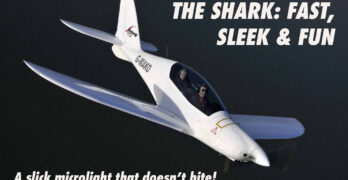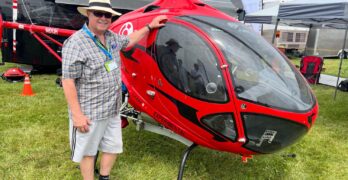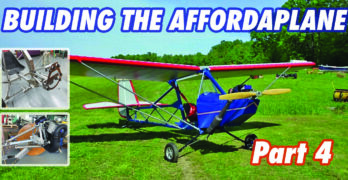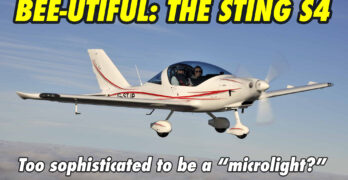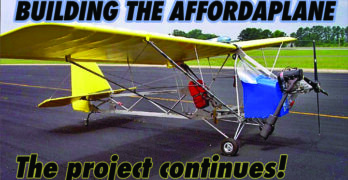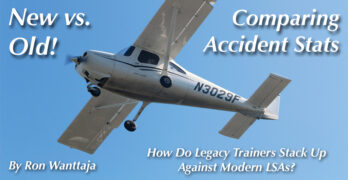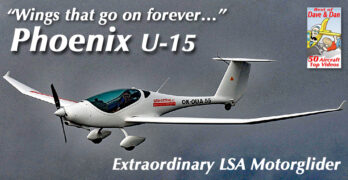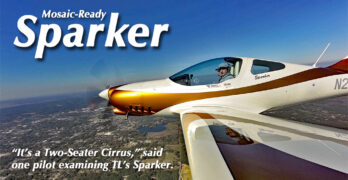“You never get a second chance to make a first impression” is a wise old saw, and my initial impressions of the Shark were all very positive. Some aircraft look like they’re moving even when they’re standing still, and the Shark definitely falls into this category. From the tip of the sharp-looking spinner to the top of the swept-back fin, it’s easily the sexiest-looking microlight I’ve ever seen. Indeed, my first thought is that it looks rather like a scaled-down PC-21.
Walking around the aircraft, I note that the 100-hp Rotax 912S is very tightly cowled, and that access to the engine bay is adequate, but not outstanding, as quite a lot of Camloc fasteners need to be undone to remove the entire cowling for a full engine inspection. There’s a large electrically actuated NACA scoop in the bottom half which supplies air to the oil cooler and radiator, and small intakes in the top half on both sides of the spinner for cooling the cylinders.
Search Results for : CT AND hand control
Not finding exactly what you expected? Try our advanced search option.
Select a manufacturer to go straight to all our content about that manufacturer.
Select an aircraft model to go straight to all our content about that model.
Cicaré 8 Kit Helicopter Debuts at AirVenture
It is hard to miss the sexy, sleek, Ferrari-red two-place helicopter on the Ultralight field at AirVenture. It’s new, it’s beautiful, and, as it turns out, it is a kit which can be completed in 200 hours, or even faster at a Cicaré builder assist facility. The two-place Cicaré 8 helicopter is appearing at AirVenture for the first time, made possible by Keith Barr, the President and CEO of the newly formed Cicaré USA corporation.
If the Cicaré name rings a bell, it is because of Augusto Cicaré, who moved from Italy to Argentina at age 19 to start and build what is now the storied Cicaré Helicopter Company. Cicaré has been designing and building helicopters for the Argentinian civilian and military since the early 1960s. Although Augusto died in January of 2022, his sons have continued the business, with great success.
The two place side by side Cicaré 8 was designed in Argentina in 2015.
Building the Affordaplane, Part 4
With this, the last chapter of the Affordaplane build, I will describe how an engine mount was created to complete the last major step. As a quick recap of the previous chapters in this series, I was attempting to plans build a legal ultralight using common tools and store-purchased materials. For example: No welding allowed! So, now the biggest challenge confronting me was creating an engine mount needed for the engine installation.
First, what engine should be used in this project? This decision could not be made until we were nearly finished with the entire project. Why? The choice of engine is determined by how much weight remains after deducting the aircraft’s total weight from the 254-pound limit imposed by the FAA ultralight regulations. With the wings and tail attached to the fuselage, I weighed the entire structure. Without an engine, the scales read very close to 200 pounds.
Flight Review: The Sleek Sting S4
“Look at that groundspeed!” I exclaimed, pointing at the Garmin EFIS. “Our TAS is nearly 125 knots, which means we’ve got a 60 knot headwind straight on the spinner!” “Can you imagine being up here in a traditional microlight?” asked the Sting’s owner, John Palmer. “No, because not only would I be scared out of my mind at the prospect of having to land, but right now we’d practically be going backwards!” I said.
I’ve written before about just how capable and potent the new breed of light sport microlights is, and several of the aircraft I’ve tested recently are not only comparable to traditional GA types, but are demonstrably superior. An excellent representative of this new breed of speedy sport planes is the Sting S4, from Czech airframer TL Ultralights.
As I wait at Saltby for John to arrive in the Sting, I’m aware that it’s extremely windy, and that if I’d told someone that I was planning on flying a microlight in such conditions, they’d probably think I was mad—or suicidal.
Building the Affordaplane, Part 3
In the previous installment, I described construction details for the fuselage section of the Affordaplane ultralight project. Now let’s look at construction of the empennage and wing assemblies. Remember, this is a plans-only type of build using off-the-shelf materials and tools intended for a novice builder. Keep this objective in mind when reviewing the construction and design details. A complete free video series on YouTube shows each step of this construction.
The components of the empennage (rudder, elevator, vertical and horizontal stabilizers) are all formed from 1-inch 6061-T6 aluminum tubing. These tubes must be bent into their respective shapes, matching template patterns drawn on your workbench. (Use some craft paper for this!) What is the easiest way to form these simple bends? I found that using an electrician’s conduit bender did the job nicely. With a little practice, each tube was formed to the proper shape and then fitted with a gusset to join its ends.
Advanced Degree in Rotax-erie
Editor’s Note: This story originally appeared in KITPLANES magazine but since so much of the LSA world depends on Rotax engines, we thought this was worth a read here.
Thirteen years into my two-year SeaRey build, OspRey finally had its engine mounted. But when I signed on the dotted line for my new Rotax 914, and with little more knowledge than how to change the oil in my car, I was nervous about my abilities to maintain this expensive engine. Because of this, back in 2014, I attended a weeklong service and maintenance class at Canadian Rotax distributor Rotech Motor, Ltd. Thanks to an excellent hands-on instructor, who acted like he had all the time in the world and a bagful of instructor tricks to teach us, by the second afternoon I had dropped my skepticism and distrust of the price/power ratio of the Rotax engine and was (almost) ready to go out and get a Rotax tattoo.
“Icon in Flat Spin,” UK’s Flyer Reported — Here’s the Latest
Icon Aircraft, creator of the A5 LSA seaplane, is in the spotlight again as bankruptcy proceedings finally come to a close.
Short story: Icon will continue making aircraft, after the bankruptcy heard from a new buyer — not the buyer mentioned before in this recent article. The court sought a change in ownership and an effort to grapple with a large amount of debt.
From beginning (in April 2024) to an end in mid-June, this proceeding moved very swiftly. Here’s the final settlement.
“Icon In a Flat Spin
as Bankruptcy Looms”
Earlier in the day on June 18th, 2024…
Britain’s Flyer magazine reported online that Icon found a buyer but not the one mentioned in the prior link.
“Buy an aircraft manufacturer with a certified product and also selling in the Light-Sport Aircraft class for, what? …£100 million? Try again and aim low: just over £12m ($15.3 million),” wrote Flyer staff.
Light Sport Accidents — New LSAs vs. Legacy Trainers
Editor’s Note: This is the second part of Ron Wanttaja’s survey of LSA safety (here’s the first). This time, he takes a close look at how modern LSAs compare with legacy trainers as epitomized by Cessna’s 152, both in terms of accident rates and the kinds of mayhem they succumb to. Let’s dive in!
In the previous safety review, we looked various forms of LSA—SLSA, ELSA and Experimental/Amateur-Built. For this article, we’ll look only at SLSA airplanes. We’re not addressing powered parachutes, weight shift or other SLSA classes—just traditional flying machines with wings and a motor. Call them “SLSA-A,” or “SLSA-As” for plural. We’ll address their accidents from 2005 through 2021.
To identify the SLSA-A accidents, I cross-referenced the NTSB accident database with FAA registrations, including both active and inactive aircraft.
What to compare them to? Let’s pick the near-ubiquitous Cessna 152. It’s close to the general definition of Light Sport, other than exceeding the LSA gross weight requirement.
Flight of the Phoenix (Motorglider) — Top 50 Video Star Is Back with News
The Top 50 video series has gone over very well and continues with this post about the Phoenix LSA motorglider. If you thought it disappeared and were unhappy about that, have I got good news for you!
I am aware of a very positive development regarding Phoenix that I am working to confirm. As soon as I have fuller details I will update this article but the prospects for LSA motorglider look promising.
In North America, Phoenix Air USA is run by Ed Babovec (email) and he is excited about 2024. …more as it unfolds.
Motorgliders as a subset of all aircraft enjoy some very special privileges that endear them to the recreational flying community. In particular, motorgliders do not require an aviation medical. That alone makes them desirable but long-gliding capabilities make them safer to some pilots and simply more enjoyable to others. Let’s look a little more deeply.
First One in the USA — Flying TL’s Luxurious, Mosaic-Ready Sparker Aircraft
Some pilots can hardly wait for Mosaic. It takes all kinds, of course.
Many aviators want to use Sport Pilot’s no-medical aspect to fly a Cessna or Piper that they can buy inexpensively (or already own). That makes sense. These affordable aircraft are familiar and proven, even if they are products of the 1950s with mostly analog instruments and powerplants that burn 10 to 15 gallons per hour of 100LL.
Another group, owners of modern LSA, wants a little more weight than allowed by current regulation. Still others may want to fly at night or in IFR or to use an economical LSA for some form of aerial work.
Then we have what I’ll call the Mosaic LSA crowd. These are pilots with larger budgets — perhaps they sold a Cirrus or Bonanza and have equity to put toward a new aircraft. These experienced pilots are accustomed to well-equipped aircraft with generous cruise speeds.
- « Previous Page
- 1
- …
- 16
- 17
- 18
- 19
- 20
- …
- 62
- Next Page »


